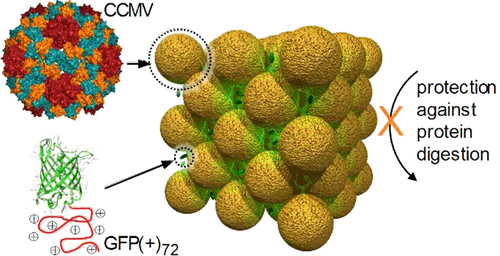当前位置:
X-MOL 学术
›
ACS Macro Lett.
›
论文详情
Our official English website, www.x-mol.net, welcomes your
feedback! (Note: you will need to create a separate account there.)
Self-Assembly of Electrostatic Cocrystals from Supercharged Fusion Peptides and Protein Cages.
ACS Macro Letters ( IF 5.1 ) Pub Date : 2018-02-19 , DOI: 10.1021/acsmacrolett.8b00023 Antti Korpi 1 , Chao Ma 2 , Kai Liu 2 , Nonappa 3 , Andreas Herrmann 2 , Olli Ikkala 3 , Mauri A Kostiainen 1
ACS Macro Letters ( IF 5.1 ) Pub Date : 2018-02-19 , DOI: 10.1021/acsmacrolett.8b00023 Antti Korpi 1 , Chao Ma 2 , Kai Liu 2 , Nonappa 3 , Andreas Herrmann 2 , Olli Ikkala 3 , Mauri A Kostiainen 1
Affiliation

|
Self-assembly is a convenient process to arrange complex biomolecules into large hierarchically ordered structures. Electrostatic attraction between the building blocks is a particularly interesting driving force for the assembly process, as it is easily tunable and reversible. Large biomolecules with high surface charge density, such as proteins and protein cages, are very promising building blocks due to their uniform size and shape. Assemblies of functional molecules with well-defined nanostructures have wide-ranging applications but are difficult to produce precisely by synthetic methods. Furthermore, obtaining highly ordered structures is an important prerequisite for X-ray structure analysis. Here we show how negatively charged ferritin and viral protein cages can adopt specific cocrystal structures with supercharged cationic polypeptides (SUPs, K72) and their recombinant fusions with green fluorescent protein (GFP-K72). The cage structures and recombinant proteins self-assemble in aqueous solution to large ordered structures, where the structure morphology and size are controlled by the ratio of oppositely charged building blocks and the electrolyte concentration. Both ferritin and viral cages form cocrystals with face centered cubic structure and lattice constants of 14.0 and 28.5 nm, respectively. The crystals are porous and the cationic recombinant proteins occupy the voids between the cages. Such systems resemble naturally occurring occlusion bodies and may serve as protecting agents as well as aid the structure determination of biomolecules by X-ray scattering.
中文翻译:

来自增压融合肽和蛋白质笼的静电共晶体的自组装。
自组装是将复杂的生物分子排列成大型分层有序结构的便捷过程。构建块之间的静电吸引力是组装过程中特别有趣的驱动力,因为它很容易调节和可逆。具有高表面电荷密度的大生物分子,例如蛋白质和蛋白质笼,由于其均匀的尺寸和形状而成为非常有前途的构建模块。具有明确纳米结构的功能分子组装体具有广泛的应用,但很难通过合成方法精确生产。此外,获得高度有序的结构是X射线结构分析的重要前提。在这里,我们展示了带负电的铁蛋白和病毒蛋白笼如何采用具有超荷电阳离子多肽(SUP、K72)及其与绿色荧光蛋白(GFP-K72)的重组融合物的特定共晶结构。笼状结构和重组蛋白在水溶液中自组装成大型有序结构,其中结构形态和尺寸由带相反电荷的结构单元的比例和电解质浓度控制。铁蛋白和病毒笼形成面心立方结构的共晶,晶格常数分别为14.0和28.5 nm。晶体是多孔的,阳离子重组蛋白占据笼之间的空隙。此类系统类似于天然存在的包涵体,可用作保护剂并有助于通过 X 射线散射确定生物分子的结构。
更新日期:2018-02-19
中文翻译:

来自增压融合肽和蛋白质笼的静电共晶体的自组装。
自组装是将复杂的生物分子排列成大型分层有序结构的便捷过程。构建块之间的静电吸引力是组装过程中特别有趣的驱动力,因为它很容易调节和可逆。具有高表面电荷密度的大生物分子,例如蛋白质和蛋白质笼,由于其均匀的尺寸和形状而成为非常有前途的构建模块。具有明确纳米结构的功能分子组装体具有广泛的应用,但很难通过合成方法精确生产。此外,获得高度有序的结构是X射线结构分析的重要前提。在这里,我们展示了带负电的铁蛋白和病毒蛋白笼如何采用具有超荷电阳离子多肽(SUP、K72)及其与绿色荧光蛋白(GFP-K72)的重组融合物的特定共晶结构。笼状结构和重组蛋白在水溶液中自组装成大型有序结构,其中结构形态和尺寸由带相反电荷的结构单元的比例和电解质浓度控制。铁蛋白和病毒笼形成面心立方结构的共晶,晶格常数分别为14.0和28.5 nm。晶体是多孔的,阳离子重组蛋白占据笼之间的空隙。此类系统类似于天然存在的包涵体,可用作保护剂并有助于通过 X 射线散射确定生物分子的结构。











































 京公网安备 11010802027423号
京公网安备 11010802027423号